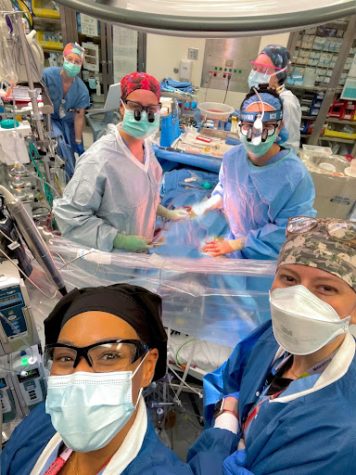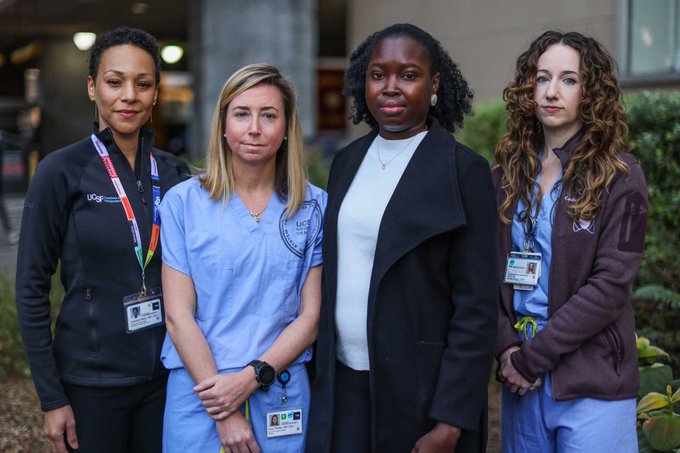Women in the Workforce—First Female Surgical Team
March 2, 2023
It has recently been announced that the University of California, San Francisco recorded its first all-female surgical team in the medical center’s history. In December, cardiac surgeon, Dr. Amy Fiedler, was wrapping up a routine heart transplant surgery when she made the groundbreaking realization that the operating room was filled entirely with women. The team consisted of seven women: Dr. Amy Fiedler, Dr. Laura Scrimgeouer (cardiac surgery fellow), Dr. Charlene Blake (cardiac anesthesiologist), Ashley Risso (perfusionist), Ruiza Coronel (registered nurse), a contact nurse, and the patient. If the organ donor was also female, that would make a total of 8 women. However, the identity of the donor remains confidential.

It has been confirmed that this was the first all-woman heart transplant surgery team in the 159-year history of UCSF, yet the occurrence was completely randomized. Dr. Fiedler explains that they were operating on a call schedule, meaning physicians are called in on short notice to tend to patients in need. She explains, “You roll the dice, and if there’s a case, then that’s what you do,” so the all-female team was formulated by luck. Although history has been made at UCSF, it is difficult to confirm if it was the first female surgical team globally as statistics are usually kept on patients rather than the attending staff.
Regardless of the global scale of the accomplishment, it remains a milestone for women in surgery. While the number of female surgeons continuously increases, the gender gap still lingers in the medical field. For example, Dr. Fiedler is the only female cardiac surgeon at UCSF. She confessed that “to be in a position at an institution where we have a woman cardiac surgery attending, a woman cardiothoracic anesthesiologist, and then a woman cardiac surgery trainee, it’s just really unique to have all of those pieces fall into place.” Although the numbers are beginning to narrow, surgery has been known as being a male-dominated field, but why? A 2019 study from JAMA Network Open, a medical journal published by the American Medical Association, revealed that gender bias is one of the main difficulties women face as surgeons. This is due to the fact that surgeons more strongly associate men with surgery and women with family medicine and that women constantly face false assumptions about their abilities. Furthermore, the absence of interactions with other women in surgery, lack of independent support, and the inflexibility of taking time off in regard to starting families are all deterrents to surgical training for women.
Even in the presence of these obstacles, women have increasingly been encouraged to pursue careers in surgery. Accomplishments similar to the female surgeons at UCSF continue to inspire and mentor the next generation of women surgeons in hopes to close the gender gap and eradicate the discrimination that lies within the medical field.
It has been confirmed that this was the first all-woman heart transplant surgery team in the 159-year history of UCSF, yet the occurrence was completely randomized. Dr. Fiedler explains that they were operating on a call schedule, meaning physicians are called in on short notice to tend to patients in need. She explains, “You roll the dice, and if there’s a case, then that’s what you do,” so the all-female team was formulated by luck. Although history has been made at UCSF, it is difficult to confirm if it was the first female surgical team globally as statistics are usually kept on patients rather than the attending staff.
Regardless of the global scale of the accomplishment, it remains a milestone for women in surgery. While the number of female surgeons continuously increases, the gender gap still lingers in the medical field. For example, Dr. Fiedler is the only female cardiac surgeon at UCSF. She confessed that “to be in a position at an institution where we have a woman cardiac surgery attending, a woman cardiothoracic anesthesiologist, and then a woman cardiac surgery trainee, it’s just really unique to have all of those pieces fall into place.” Although the numbers are beginning to narrow, surgery has been known as being a male-dominated field, but why? A 2019 study from JAMA Network Open, a medical journal published by the American Medical Association, revealed that gender bias is one of the main difficulties women face as surgeons. This is due to the fact that surgeons more strongly associate men with surgery and women with family medicine and that women constantly face false assumptions about their abilities. Furthermore, the absence of interactions with other women in surgery, lack of independent support, and the inflexibility of taking time off in regard to starting families are all deterrents to surgical training for women.
Even in the presence of these obstacles, women have increasingly been encouraged to pursue careers in surgery. Accomplishments similar to the female surgeons at UCSF continue to inspire and mentor the next generation of women surgeons in hopes to close the gender gap and eradicate the discrimination that lies within the medical field.










